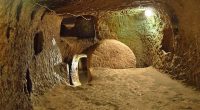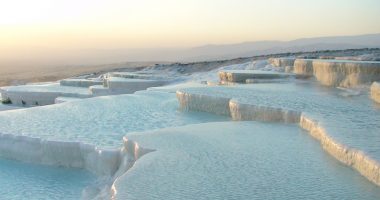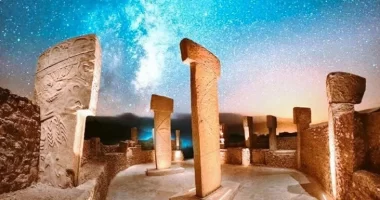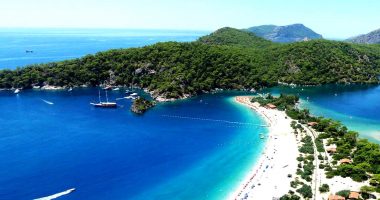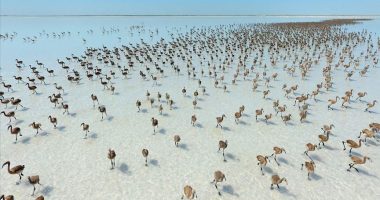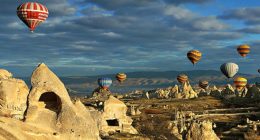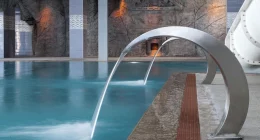Table of Contents
- 1- What does Hagia Sophia mean?
- 2- Hagia Sophia was built three times
- 3- The columns and marbles of Hagia Sophia were brought from ancient cities
- 4- Domes of Hagia Sophia
- 5- Emperors Gate
- 6- Apse Mosaic
- 7- Two Angels in the Apse
- 8- Viking Writing
- 9- VI. Leon Mosaic
- 10- Presentation Mosaic
- 11- Angel Depictions in the Dome
- 12- Patriarch Mosaics in Tympanon
- 13- Emperor Alexandros Mosaic
- 14- Zoe and Komnenos Mosaics
- 15- Tombstone of Commander Henricus Dandolo
- 16- Deisis Composition
- 17- Omphalion
- 18- Wish Column
- 19- Minarets of Hagia Sophia
- 20- Struts
- 21- Marble Cubes
- 22- Pulpit
- 23- Sultan’s Assembly
- 24- Altar
- 25- Tiles Around the Altar
- 26- Calligraphy Plates in the Altar Section
- 27- Shadirvan
- 28- Sultan Mahmud I Library
- 29- Mosaic Tugra of Sultan Abdulmecid
- 30- Eight Large Line Sheets
Hagia Sophia, which is among the most visited museums in the world; It is one of the most prominent monuments in the world in terms of the history of art and architecture. It was described as the 8th wonder of the world by Philo of the East in the 6th century BC.
This historical building, which was used as a church for 916 years, was converted into a mosque by Fatih Sultan Mehmed in 1453 with the conquest of Istanbul and used as a mosque for 482 years. With the order of Atatürk and the decision of the Council of Ministers, it opened its doors as a museum in 1935. In 2020, with the decision of President Recep Tayyip Erdoğan, it was turned into a mosque and opened to Muslims.
In this article, we have compiled 30 things you need to know about Hagia Sophia.
You may be interested: Oludeniz
1- What does Hagia Sophia mean?
When Hagia Sophia was first built, it was called the Great Church (Megale Ekklesia). However, the Church began to be called Sophia from the 5th century. Despite this, it continued to be popularly referred to as the Great Church. After the conquest in 1453, the name of the church was changed to “Hagia Sophia” as it is still used today.
The idea that the building was dedicated to a saint named Sophia, which is one of the views on where the name came from, is wrong. The church was dedicated to Theia Sophia, the second element of the Christian trinity, Holy Wisdom. The word Hagia Sophia, which was later named after, is composed of the words Aya (holy, saint) and Sophos (wisdom), meaning holy/divine wisdom.
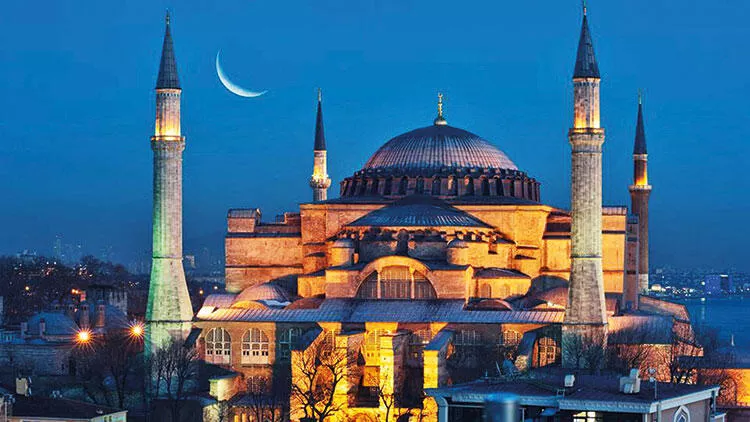
2- Hagia Sophia was built three times
The first building of Hagia Sophia was built on the first hill (Sarayburnu), in the form of a wooden basilica in the 4th century. Although this first structure is usually attributed to Konstantinos I (324-337), the church was completed in the time of his son Konstantios (337-361), and the opening ceremony of the first structure of Hagia Sophia was held on February 15, 360.
This first building did not last very long. On June 20, 404, the church was burned in the fire that broke out in the exile of the patriarch Ioannes Chrysostomos and the uprising that followed. Theodosius II (408-450) had the building rebuilt with five naves and the church was reopened on 10 October 415.
The second church was burned again in the Nika uprising, which broke out on the night of 13-14 January in 532, against Justinian (527-565) and his wife. On top of that, the emperor commissioned Anthemios of Tralles and Isidoros of Miletos to build a larger church from the groundbreaking and old buildings instead of restoring the church in accordance with its previous state.
Prokopios (500-562) wrote that the rebuilding of the church began on February 23. Hagia Sophia, which has survived to the present day, was also the structure that was rebuilt on this date. The construction of the structure lasted until 537. It is known that Justinian was directly interested in the building. Hagia Sophia was opened with a great ceremony on December 27, 537.
3- The columns and marbles of Hagia Sophia were brought from ancient cities
Justinian requested materials from all over the empire for the rebuilding of the church, and he also collected the processed materials of the old buildings. Thereupon, eight large red porphyry columns were brought from Heliopolis in Egypt, from the Temple of Artemis in Western Anatolia Ephesos, from Kyzikos and from Ba’lebek in Syria. In addition, marbles of different types and colors from different regions were moved here.
4- Domes of Hagia Sophia
The most important innovation in the architecture of Hagia Sophia was its unusual size for a church, the size and height of the dome dominating the middle space. The height of the dome covering the main space is 55.60 meters from the ground, its diameter is 31.87 meters in the north-south direction and 30.86 meters in the east-west direction. While the Hagia Sophia was being built, marble, stone and brick were used by the architects in the construction of the building, and light and strong bricks specially produced from Rhodes soil were used to prevent the dome from collapsing easily in earthquakes.
5- Emperors Gate
The door, called the Emperor’s Gate because it was used only by the Emperor and his nature, provides the transition from the inner narthex to the main space in Hagia Sophia. This is the largest door of Hagia Sophia and is made of oak wood, 7 meters high, with a bronze frame. The wings of the gate, which date back to the 6th century, are covered with bronze plates. Eastern Roman sources claim that it was made from the woods of Noah’s Ark. The mosaic on it is the first unearthed mosaic of Hagia Sophia.
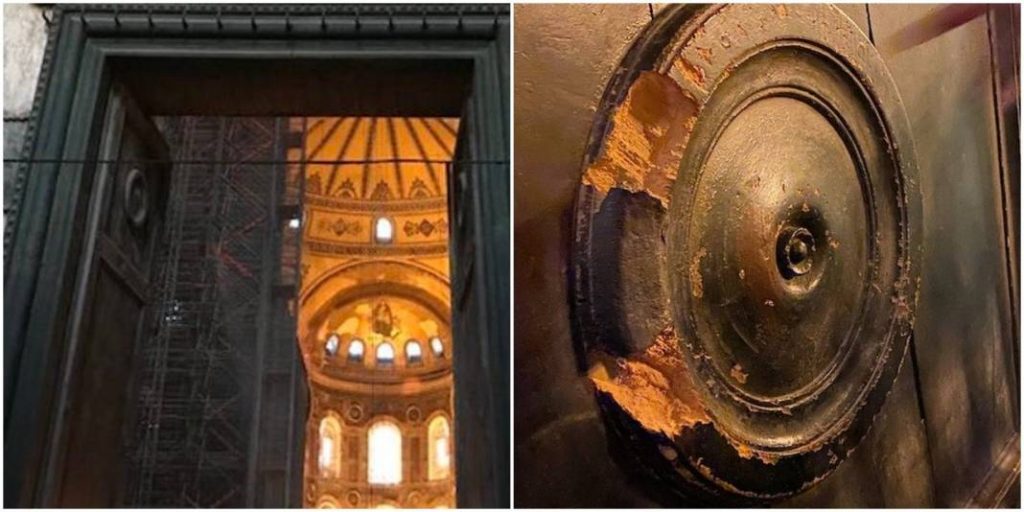
6- Apse Mosaic
It is thought that all the figured mosaics in the building were removed with the iconoclasm period. After the end of this period in 843, the first figured mosaic, the Apse Mosaic, was made in Hagia Sophia. In mosaic; In the middle, the Virgin Mary is depicted sitting on a cushioned throne decorated with precious stones. She is holding the child Jesus in her arms.
7- Two Angels in the Apse
On the right of the apse is the depiction of Gabriel, and on the left is the depiction of Michael. Although the depiction of Gabriel has survived to a large extent, the sacred wing tip and part of the foot in the depiction of Michael have survived to the present day. The depiction of these two angels is thought to have been added to the apse in the second half of the 9th century.
Hagia Sophia, which is among the most visited museums in the world; It is one of the most prominent monuments in the world in terms of the history of art and architecture. It was described as the 8th wonder of the world by Philo of the East in the 6th century BC.
8- Viking Writing
In the middle of the south gallery, on the marble balustrades, there is a Viking inscription, apparently from the 9th century. This article says “Halvdan was here”. It is thought to have been written by a Viking soldier working as a mercenary in the army in Eastern Rome.
9- VI. Leon Mosaic
The mosaic, dated to the 10th century, is located on the Emperor’s Gate. The depiction of Jesus in the middle of the scene holds an open Bible in his left hand. With his right hand, he blesses Emperor Leon VI (816-912), who is depicted prostrating to him at his feet. On the right of the mosaic, there is a depiction of Gabriel in a medallion, and on the left, a depiction of Mary in a medallion.
10- Presentation Mosaic
It is located above the Beautiful Gate to the south of the inner narthex. The mosaic found on the ceremonial gate used by the empire and its family was unearthed by Fossati in 1849 during the restoration of Hagia Sophia. In the middle of the panel made of gold mosaics, the Virgin Mary and the child Jesus on her lap are depicted.
On the left side of the Virgin Mary, Konstantinos is depicted with a figure symbolizing Constantinople, and on the right side, Justinian is depicted with a figure symbolizing Hagia Sophia. It is told here that the emperors presented the city and the church to Mary to protect the city and the church.
11- Angel Depictions in the Dome
In each corner of the pendants, Seraphim angels, who are believed to protect the throne of God in heaven, are depicted. The angel depictions in the eastern part are made of mosaic. The ones in the west were renovated as frescoes because they were damaged during the Eastern Roman Period. Angel depictions were closed during the Ottoman Period.
12- Patriarch Mosaics in Tympanon
Although the exact dates of their construction are unknown, these mosaics, which are thought to have been made in the 9th to 10th centuries, are located in half-arched niches on the tympanon walls in the north of the building. Only three of the patriarch figures depicted in the mosaics have survived to the present day in a well-preserved condition.
The Patriarch of Constantinople Young Ignatios is in the first niche, the Patriarch of Constantinople St. Ioannes Chrysostomos is in the fourth niche, and the Patriarch of Antiocheia St. Ignatios Theophoros is in the sixth niche. The figure depicted in the seventh niche is thought to be Athanasius.
13- Emperor Alexandros Mosaic
In the mosaic located in the southwest part of the north gallery, VI. The brother Emperor Alexandros (912-913), whom Leon shared in his reign, is depicted. The mosaic dating back to the 10th century is one of the most intact mosaics among the Hagia Sophia mosaics.
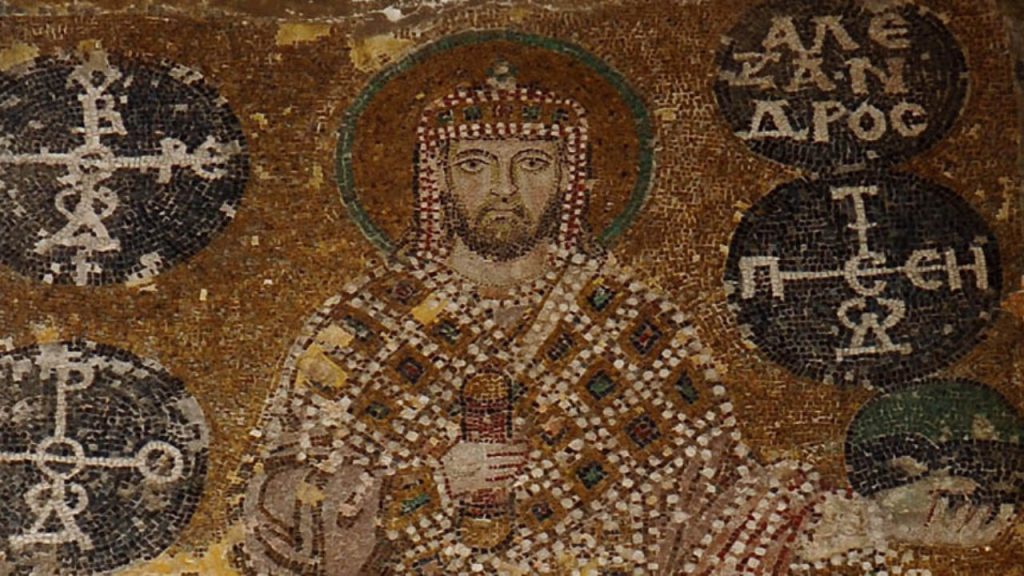
14- Zoe and Komnenos Mosaics
Zoe Mosaic, one of these mosaics, located on the wall at the eastern end of the south gallery of Hagia Sophia, is dated to the first half of the 11th century. In its present form, Jesus sitting in the center and Empress Zoe placed on either side of him and his wife Emperor Constantine IX (1042-1055) are depicted. Although there is a depiction of Kontantinos IX in the present form of the mosaic, it was probably made for the first time during the reign of Romanos III (1028-1034), Zoe’s first wife.
In the Komnenos Mosaic, on the other hand, the Virgin Mary holding the child Jesus standing in front of her in the center and Emperor Ioannes II Komnenos (1118-1143) and his wife Empress Eirene are depicted on either side. On the right side of the mosaic, there is the couple’s son Alexios. It is generally accepted that the subject of these two mosaics is the donations made by the emperors to Hagia Sophia. The money bags in the hands of the emperors in the mosaics prove this situation.
15- Tombstone of Commander Henricus Dandolo
The tombstone, located opposite the Deisis Mosaic, belongs to Commander Henricus Dandolu, who led the IV Crusade and died in Constantinople in 1205.
16- Deisis Composition
The Deisis Mosaic, located on the pediment of the door opening to the gallery in the parsonage, is one of the most famous mosaics of Hagia Sophia. Although there are different opinions about its dating, the mosaic, which is accepted to be made in the 13th century, is considered an important beginning in Eastern Roman Painting Art. In the mosaic, Ioannes Prodromos is depicted on the right of Jesus in the middle of the scene and Mary on the left. Mary and Ioannes Prodromos are depicted as pleading to Jesus for the forgiveness of humanity on the Day of Judgment. These three figures reflect the Hellenistic Period depiction art.
17- Omphalion
The omphalion, the room where the emperors were crowned with ceremonies in Eastern Rome, is an area where circles of different colors and sizes around the large marble circle and opus sectile decoration can be seen at their junctions.
18- Wish Column
The column in the northwest direction with a carved center is called the sweating column or the wishing column. There are several myths about the column. According to one of them; Emperor Justinianus, while walking around the building in a severe headache, realizes that his head hurts when he leans on this column, and when this event is heard among the people, it is believed that this column heals.
According to another rumor, after the building was turned into a mosque, the first Friday prayer to be held here could not be started because the direction of the building was not facing the Kaaba, but at that time “Hızır Aleyhisselam” came and tried to turn the direction of the structure to the Kaaba by taking strength from this column. However, when this event was noticed by one of the people, it is said that the mosque disappeared without being able to turn its direction.
The habit that has survived from the myths is that people make a wish by turning their thumbs in this hole in the column one full turn clockwise.
19- Minarets of Hagia Sophia
After the conquest of Istanbul, after the Hagia Sophia church was turned into a mosque, a wooden minaret was built by Fatih on one of the half-domes, but this minaret has not survived.
The minaret in the southeast is the name of Fatih Sultan Mehmet or II. It belongs to the Bayezid period. Due to the similarity of the minaret on the side of Bab-ı Hümayun with the minarets of Edirne Selimiye Mosque, II. It is thought to have been built by Mimar Sinan during the Selim period. The co-minarets in the southwest and northwest directions were built by Mimar Sinan during the reign of Sultan Murad III. In the repairs made in the 15th, 16th and 19th centuries, decorations were added to the minarets according to the style of the period.
20- Struts
Although the walls of Hagia Sophia were subjected to certain reinforcement interventions due to the external openings experienced in the Eastern Roman Empire and Ottoman Periods due to the weight of its dome, these were not sufficient. For this reason, both the Eastern Romans and the Ottomans tried to prevent the pressure of the dome by building buttresses from the outside of the structure.
Architect Sinan found a solution to this problem by supporting the building with arch additions and heavy abutment walls, the gaps between the piers and side walls supporting the dome. The supporting walls built in the Eastern Roman period were rebuilt and taken into stone enclosures. A total of 24 buttresses, 7 in the East, 4 in the South, 4 in the North, 5 in the West, and 4 in the weight towers, were built in the Eastern Roman Period and some in the Ottoman Period.
21- Marble Cubes
Two jars from the Hellenistic Period, found in the ancient city of Pergamon and made of monolithic marble, were brought to Hagia Sophia during the reign of Sultan Murad III. There are taps at the bottom of the cubes. Sherbet was dispensed from these jars, which could hold 1250 liters of liquid, in oil lamps and Eid prayers.
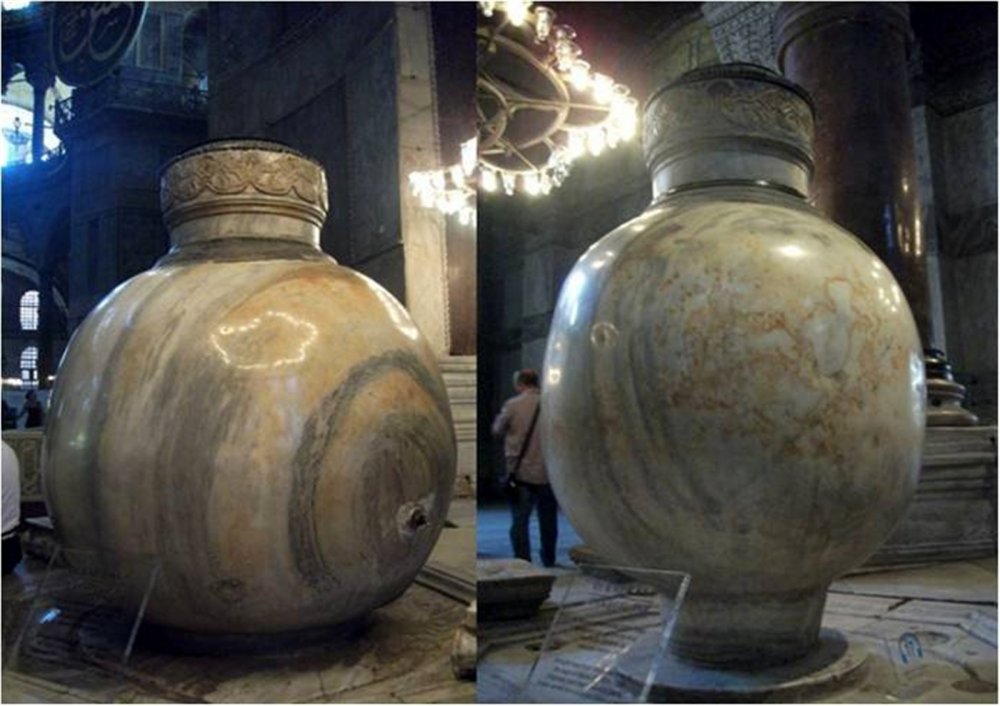
22- Pulpit
Sultan III. The pulpit built during the reign of Murad is located to the right of the altar. Dating to the 16th century, the pulpit is one of the best examples of marble workmanship of this period.
23- Sultan’s Assembly
During the period when Sultan Ahmed III had Hagia Sophia completely overhauled, he had the Hünkar Mahfili built in 1728, which he ordered with his own pleasure. This mahfil was replaced with a new one in 1847 during the maintenance and repair done by Sultan Abdülmecid. The Hünkar Mahfili consists of a hexagonal section on five columns and a corridor that rests on columns. The lower part consists of a marble openwork balustrade plate. It has a gilded wooden cage on top.
24- Altar
The altar, located in the southeast of the main space, was repaired and added by the Ottoman sultans from time to time. Renovated in the 19th century, the altar has a polygonal niche with sunburst and star motifs and a semi-domed hood. A lot of gold stars are used in the altar and it has an ostentatious crest. On both sides of the altar, there are candlesticks brought from the palace church of the Hungarian King Matyas I during the Hungarian campaign during the reign of Suleiman the Magnificent (1520-1566).
25- Tiles Around the Altar
There are tile panels in the corridors on the right and left of the altar. On the left, there is a tile panel with plant motifs belonging to the Old Sultan’s Mahfili, consisting of 16th century Iznik tiles. On the right panel, the Kaaba depiction consisting of eight parts and Hz. There is a picture showing the tomb of Muhammad.
26- Calligraphy Plates in the Altar Section
On the right side of the altar, there are calligraphy plates belonging to the Ottoman sultans. From top to bottom; 1st line plate, Sultan II. Mahmud (1808-1839), 2nd line plate, Sultan II. Mahmud (1808-1839), 3rd line plate, Sultan III. Ahmed (1703-1730), 4th line plate, Sultan II. Mustafa (1695-1703), 5th line plate, Sultan II. It was written by Mustafa (1695-1703). On the left, there are works by Mehmed Yesari and Şeyhülislam Veliyüddin Efendi.
27- Shadirvan
It was built by Sultan Mahmut I during the repair and construction of additional buildings in Hagia Sophia (1740-1741). It was built in large dimensions in the area between the Sıbyan School and the gate, which was built in the area where the western entrance of the building was not used for a long time.
The fountain has an eight pointed arched portico with wide openings based on eight columns with muqarnas capitals. There is a 16-section marble water pool in the middle of the building. There is a marble fountain center in the middle of the pool. A small dome rises in the middle of the wooden eaves. The interior of the dome is divided into sections with gilded laths on a blue background. The general architecture of the building adheres to the classical Turkish style traditions. In addition to the motifs suitable for the Turkish art style, there are also motifs made in accordance with the Baroque style.
28- Sultan Mahmud I Library
Sultan Mahmud I Library, also known as Hagia Sophia Library, was founded by Sultan Mahmud I and was opened on April 21, 1740. According to historian Subhi Mehmet, when the library was founded, it had a collection of 4000 works. One part of this collection consisted of the books that came from the Treasury, and the other part consisted of the books that the grand vizier, sheikh al-Islam, Darüssaade aghas and other statesmen gave to Mahmud I. In the catalog of the books here, there is an entry on Mahmud I’s founding of the library, the seals of approval of the Haremeyn inspector and the Anatolian and Rumelian soldiers.
Note: Click for German dream interpretations
29- Mosaic Tugra of Sultan Abdulmecid
The tugra, embroidered with mosaic on a round plate on the wall on the right side of the big door, belongs to Sultan Abdülmecid (1839-1861). The fact that the 19th century Ottoman sultan’s tughra is made of mosaics is important in that it is the only sultan’s tughra made with mosaic grains in Turkish Art.
Architect Fossati, who was assigned to repair Hagia Sophia for the construction of Sultan Abdülmecid’s tughra, who wanted this important building to be seriously repaired and overhauled, decided to use the mosaic grains that were poured and collected during the repair of Hagia Sophia for the sultan’s signature. Thus, he commissioned the Italian mosaic artist Lanzoni.
Lanzoni embroidered Abdulmecid’s tughra with colorful mosaic grains on a floor covered with gold grains on a round record. At the time it was done, this work could not be placed anywhere and was forgotten. After many years, this work was found in the warehouse of the Topkapı Palace Museum. Later, the tugra was placed on the side wall of the main entrance, known as the Emperor’s Gate, which opened to the main space in Hagia Sophia.
30- Eight Large Line Sheets
These plates were written by calligrapher Kazasker Mustafa İzzet Efendi with gold gilding on a green ground made of hemp during the repairs made between 1847-1849 during the reign of Sultan Abdülmecid (1839-1861). “God, St. Mohammed, The Four Caliphs; Hz. Abu Bakr, Mr. Omar, Mr. Osman, Mr. Ali and Hz. Descendants of Muhammad Hasan and Hz. It is known that eight plates on which the names of “Hussein” are written are among the largest calligraphy plates in the Islamic World.
It is known that the course of the plates in Hagia Sophia, which changed after the conquest, changed in line with the wishes of the sultans who came to the reign. The diameter of the giant plates is 7.5 meters and the thickness of the letters is 35 cm.
